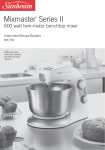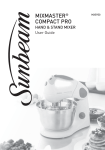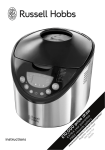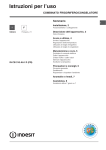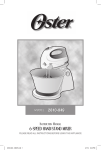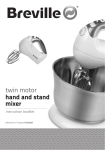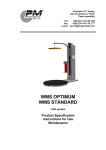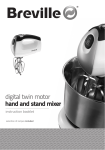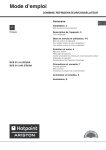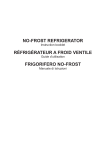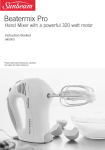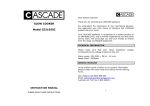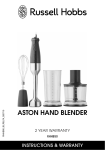Download Mixmaster® Compact
Transcript
Mixmaster Compact ® Instruction Booklet MX5900Sunbeam Mixmaster® Compact – 350 watt twin-motor stand/hand mixer. MX5950Sunbeam Mixmaster® Compact Pro – 400 watt twin-motor stand/hand mixer. Please read these instructions carefully and retain for future reference. Contents Sunbeam’s Safety Precautions 1 Features of your Mixmaster® Compact 2 Features of your Mixmaster® Compact Pro 4 Using your Mixmaster® Compact/Compact Pro 6 Role of the Twin-Motor 3-Way Beating Action 8 Mixing Guide Oven Temperature Guide 8 9 Care and Cleaning 10 Let’s Talk Ingredients 11 Cookery Tips for Best Results 13 Helpful Hints for a Successful Dough 14 Helpful Hints for Better Cake Making 16 Recipes Baking 18 Celebration Cakes 23 Icing, Fillings, Frosting & Creams 25 Brunch, Lunch and Afternoon Tea 26 Pre-Dinner Nibbles 28 After-Dinner 30 Kids Treats 31 Sunbeam’s Safety Precautions SAFETY PRECAUTIONS FOR YOUR SUNBEAM MIXMASTER COMPACT AND SUNBEAM MIXMASTER COMPACT PRO. • Never eject beaters or dough hooks when the appliance is in operation. • Ensure fingers are kept well away from moving beaters and dough hooks. Sunbeam is very safety conscious when designing and manufacturing consumer products, but it is essential that the product user also exercise care when using an electrical appliance. Listed below are precautions which are essential for the safe use of an electrical appliance: • Read carefully and save all the instructions provided with an appliance. • Always turn the power off at the power outlet before you insert or remove a plug. Remove by grasping the plug - do not pull on the cord. • Turn the power off and remove the plug when the appliance is not in use and before cleaning. • Do not use your appliance with an extension cord unless this cord has been checked and tested by a qualified technician or service person. • Always use your appliance from a power outlet of the voltage (A.C. only) marked on the appliance. • This appliance is not intended for use by persons (including children) with reduced physical, sensory or mental capabilities, or lack of experience and knowledge, unless they have been given supervision or instruction concerning use of the appliance by a person responsible for their safety. • Children should be supervised to ensure that they do not play with the appliance. • The temperature of accessible surfaces may be high when the appliance is operating. • Do not operate for more than 3 minutes at a time when mixing heavy loads. None of the recipes in this manual are considered a heavy load. • Switch off the appliance and disconnect from supply before changing accessories or approaching parts that move in use. • Never leave an appliance unattended while in use. • Do not use an appliance for any purpose other than its intended use. • Do not place an appliance on or near a hot gas flame, electric element or on a heated oven. • Do not place on top of any other appliance. • Do not let the power cord of an appliance hang over the edge of a table or bench top or touch any hot surface. • Do not operate any electrical appliance with a damaged cord or after the appliance has been damaged in any manner. If damage is suspected, return the appliance to the nearest Sunbeam Appointed Service Centre for examination, repair or adjustment. • For additional protection, Sunbeam recommend the use of a residual current device (RCD) with a tripping current not exceeding 30mA in the electrical circuit supplying power to your appliances. • Do not immerse the appliance in water or any other liquid unless recommended. • Appliances are not intended to be operated by means of an external timer or separate remote control system. • This appliance is intended to be used in household and similar applications such as: staff kitchen areas in shops, offices and other working environments; farm houses; by clients in hotels, motels and other residential type environments; bed and breakfast type environments. If you have any concerns regarding the performance and use of your appliance, please visit www.sunbeam.com.au or contact the Sunbeam Consumer Service Line. Ensure the above safety precautions are understood. 1 Features of your Mixmaster® Compact – MX5900 10 speed control switch 5 high range speeds for mixing and 5 low range speeds for kneading. Eject button The eject button effortlessly releases the beaters or dough hooks for easy cleaning. Twin motor 3-way beating action Sunbeam have further developed the famous 3-way beating action. The patent pending twinmotor design enables one motor to drive the individual beaters, each turning in opposite directions. The other motor drives the bowl, thus combined, this new technology results in a more powerful and thorough mixing result. Special ‘V-groove’ beaters Specially designed for optimum mixing and aeration. The beaters are positioned off-centre for easy addition of ingredients during mixing. 3 litre toughened plastic mixing bowl Dough hooks The heavy-duty steel dough hooks take the hard work out of kneading dough and other heavy mixtures. 2 Boost button The Boost feature provides that extra power when you need it. Tilt back locking head button The head of the mixer tilts back and locks securely into position to allow for easy removal of the mixing bowl and beaters. Hand beater release button Designed for maximum use the mixer transforms into a convenient hand mixer, as the head of the mixer simply detaches from the mixing stand. Bowl speed control dial 3 Features of your Mixmaster® Compact Pro – MX5950 10 speed control switch 10 speeds that range from high speeds for whisking and low speeds for kneading. Eject button The eject button effortlessly releases the beaters or dough hooks for easy cleaning. Twin motor 3-way beating action Sunbeam have further developed the famous 3-way beating action. The patent pending twinmotor design enables one motor to drive the individual beaters, each turning in opposite directions. The other motor drives the bowl, thus combined, this new technology results in a more powerful and thorough mixing result. Special ‘V-groove’ beaters Specially designed for optimum mixing and aeration. the beaters are positioned off-centre for easy addition of ingredients during mixing. 3 litre stainless steel mixing bowl Ideal for mixing delicate ingredients. Dough hooks The heavy-duty steel dough hooks take the hard work out of kneading dough and other heavy mixtures. 4 Boost button The Boost feature provides that extra power when you need it. Tilt back locking head button The head of the mixer tilts back and locks securely into position to allow for easy removal of the mixing bowl and beaters. Hand beater release button Designed for maximum use the mixer transforms into a convenient hand mixer, as the head of the mixer simply detaches from the mixing stand. Bowl speed control dial Mixing bowl storage lid Ideal for allowing mixtures to sit in the refrigerator. 5 Using your Sunbeam Mixmaster® Compact / Compact Pro Before use Before assembling your mixer, be sure the power cord is unplugged from the power outlet and the speed control switch is in the ‘0’ OFF position. 1. P ress the ‘tilt’ button, located on top of the neck of the mixer. While the button is depressed, hold the handle and ease the head of the mixer back, see figure 1. The mixer head will lock into this tilt position, see figure 2. 2.Select the desired attachments, depending Figure 1 Press ‘tilt’ button and tilt mixer head backward on the mixing task to be performed: beaters for whisking, mixing and beating, or dough hooks for kneading. Inserting the beaters 3a.Beaters can be inserted in either socket, as the beaters are identical. Inserting the dough hooks 3b.To insert the dough hooks, place the dough hook with the small washer into the left socket. Place the other dough hook into the right socket. Note: Ensure both beaters or dough hooks are fully inserted into the correct sockets or your mixing results may be affected. 4. P lace the 3 litre mixing bowl onto the turntable and lock into place, see figure 3. Figure 3 Figure 2 5.To lower the head of the mixer and beaters/dough hooks into the bowl, depress the ‘tilt’ button, hold the handle with the other hand and ease the head of the mixer down. A ‘click’ will indicate when the head has reached the correct position, see figure 4 over page. 6 Using your Sunbeam Mixmaster® Compact / Compact Pro (continued) Figure 4 Press ‘tilt’ button and ease mixer head down When adding dry ingredients use the lowest speed to prevent the ‘snow storm’ effect. Tip: When kneading yeast doughs, use ‘LO’ speed 1 to achieve best results. (For specific instructions for the use of dough hooks see Helpful Hints for a Successful Dough on page 14). 3. W hen mixing is complete, turn the speed control switch to the ‘0’ OFF position and unplug the cord from the power outlet. Using your mixer 1. With the speed control switch in the ‘0’ OFF position, plug the power cord into a 230-240V AC power outlet. 2. U se the speed control switch to turn the mixer ‘ON’ and ‘OFF’ and to control the mixing speeds. Clearly marked instructions for correct mixing speeds for each type of mixture are shown in the Mixing Guide on page 8. 4. H old down the ‘tilt’ button and ease the head of the mixer back until the mixer head is locked into the tilt position, see figures 1 and 2. 5. To remove the beaters/dough hooks, place fingers loosely around the spindles and press the eject button located at the front of the head of the mixer, see figure 5. Press eject button Figure 5 Tip: Always start mixing at slow speeds and increase the speed gradually to prevent ingredients splashing out of the mixing bowl. 7 Role of the Twin-Motor 3-way Beating Action One motor is located in the head of the mixer. This drives the individual beaters, turning each in opposite directions. These actions combine to ensure a more powerful and thorough mixing result. The second motor is located in the neck of the mixer and drives the turntable, in turn rotating the bowl. High or low bowl speed can be selected by simply turning the control dial positioned on the neck of the mixer, see figure 6. Figure 6 Mixing Guide 8 Mixing Task Folding & Blending Light Mixing Creaming & Beating Whipping & Aerating Recommended Speed(s) ‘LO’ 1 and 2 ‘LO’ 3 and 4 ‘HI’ 2 and 3 or ‘LO’ 5 ‘HI’ 4, 5 and Boost Oven Temperature Guide For your information, the following temperature settings are included as a guide. These settings may need to be adjusted to suit the individual range. Thermostat Settings DESCRIPTION OF OVEN TEMPERATURES Degrees Celcius °C Degrees Farenheit °F Gas Mark 120 250 ½ 140-150 300 1-2 Moderately Slow 160 325 3 Moderate 180 350 4 Moderately hot 200 400 6 Hot 220 425 8 Very Hot 240 475 9 Very Slow Slow Note: I f using fan forced ovens be sure to turn the temperature down by 20°C. Also check recipes at the back of this booklet. 9 Care and Cleaning Before cleaning your Sunbeam Mixmaster® Compact / Compact Pro, ensure the power is turned off at the power outlet, then remove the plug. Wipe over the outside area of the mixer and turntable with a dampened cloth and polish with a soft dry cloth. Wipe any excess food particles from the power cord. Wash the mixing bowl, beaters and dough hooks in warm soapy water and wipe dry. The beaters and dough hooks may also be placed and washed in the dishwasher. Important: Do not place the mixing bowl in the dishwasher. Maintenance Service Your Sunbeam Mixmaster ® Compact / Compact Pro should be regularly checked. After approximately four years of domestic use, the grease in the gear compartment should be examined (commercial use after two years). We suggest at that time you send the Mixer to your nearest Sunbeam Appliance Service Centre to ensure efficient, correct servicing. 10 Note: The mixer and the turntable have been factory oiled and no additional home oiling is necessary. Storage Keep your mixer in a convenient position on your kitchen bench ready for use at all times. Place the beaters and dough hooks into the bowl (storage of beaters and dough hooks in a drawer with other kitchen equipment may cause damage). Note: Never wind the power cord around the motor after use as the warmth of the motor may cause damage to the power cord. Lets Talk Ingredients Listed below is a guide regarding some of the ingredients used in the recipes in this book. Shortenings The word, shortening, is a term used to describe any one of the solid fats (animal, vegetable or a mixture) which is suitable for general use. Some are more suited than others for particular recipes and are therefore specified. Where the term shortening is used, select the one most pleasing to your palate. It is possible to mix or substitute according to your requirements. Examples include; Cotton seed oil and soybean. Butter Butter is made from approximately 80% milk fat (cream) and is churned over a period of time to produce a solid (butter). Butter is used to stabilize, texturize and add flavour. Butter may be salted or unsalted, it is best to use unsalted butter for cake baking. Clarified butter has the milk solids and salt removed, which is ideal for pastry making as it can be heated to higher temperatures than regular butter. Note: Margarine can be used as a substitute for butter. It is made from vegetable oils, therefore it may alter the end result. There are various types of margarines, some of these are butter-margarine blends and fat reduced. Yeast A raising agent used in doughs. Yeast is a microscopic living organism that grows rapidly in suitable warm, moist conditions. The yeast plant feeds on sugar and expels carbon dioxide which expands the gluten framework. When foaming yeast do not allow the temperature to exceed 46°C, as this prevents killing the yeast. A 26˚C - 30˚C, draft free area is most suitable for the growth of yeast during the rising process. Both Dry Yeast and fresh Compressed Yeast may be used in the recipes included in this book. (NB. 7g of dry yeast is equivalent to 15g of compressed yeast). Substitutes If you find it necessary to substitute ingredients in a recipe, check the following alternatives: 1 cup self raising flour = 1 cup plain flour and 2 teaspoons baking powder. 1 cup plain flour and 1 teaspoon baking powder = 1/2 cup each of plain and self raising flour. 1 tablespoon arrowroot = 1 tablespoon cornflour. Sultanas = equal measure of any other dried fruit. Golden Syrup = equal measure of honey or treacle. 1 cup buttermilk = 1 cup fresh milk and 2 teaspoons vinegar or lemon juice. 11 Lets Talk Ingredients (continued) Measuring Ingredients Careful and correct measurement of all ingredients is essential for recipe success. Australian Standard Metric cup and spoon measures are used in all recipes in the book. All cup and spoon measurements should be level. The following are some hints on measuring ingredients. Wet Ingredients Place the measuring jug on a level surface and check the measurement at eye level. Dry ingredients Use a standard metric measuring cup and spoon to measure out dry ingredients. After filling, level off cup or spoon with a knife. You may like to tap the cup or spoon lightly on the kitchen benchtop before levelling. If your dry ingredients has any lumps, be sure to remove them or break them up, sifting ingredients prior to mixing will help. 12 Raising Agents Care is essential for best results. Check for and crush any lumps, particularly in bicarbonate of soda, before measuring. Cheese and Breadcrumbs Pack grated cheese and soft breadcrumbs into the cup pressing lightly to obtain best results. Fats and Oils The simplest method to measure butters, margarines and shorting is to cut or spoon the required amount from the block or container and then weigh it using metric scales. Cookery Tips for Best Results 1. Before starting, read the recipe completely. 2. Refrigerated ingredients, ie butter and eggs should be at room temperature before mixing begins. Set these ingredients out ahead of time. 3. Before starting your recipe preheat oven to baking temperature recommended in the recipe. 4. Assemble all ingredients and utensils near the mixer. 5. To eliminate the possibility of shells or deteriorated/off eggs in your recipe, break eggs into a separate container first, then add to the mixture. 6. When mixing egg whites, be sure the bowls and beaters are thoroughly cleaned and dried. As even the smallest amount of oil on beaters or bowl may cause the egg whites not to aerate. 7. Always start mixing at slow speeds. Gradually increase to the recommended speed as stated in the recipe. 8. When mixing small quantities we recommend using the mixer as a hand mixer. 9. Do not overbeat. Be careful that you only mix/blend mixtures until the recommended time specified in your recipe. Fold in dry ingredients only until just combined. Always use the low speed. At any stage of mixing, over beating can cause toughness, close texture, lack of rising or excessive shrinkage. Climatic conditions, seasonal temperature changes, temperature of ingredients and their texture variation from area to area all play a part in the required mixing time and the results achieved. 10. All recipes have been kitchen tested, but should you find it necessary to vary the ingredients or the size of the tin etc. allow for a variation in cooking time. Always test for doneness in baked foods before removing from the oven or the cooking appliance. 11.During mixing, ingredients may splash to the sides of the bowl. To scrape the bowl, turn the beaters and bowl Control Dials to the ‘OFF’ position and using a plastic or rubber spatula, scrape the bowl. NEVER USE A KNIFE, METAL SPOON OR FORK, as this may cause damage to the beaters and bowl. A light scraping after the addition of each ingredient assists in achieving efficient mixing. 13 Helpful Hints for a Successful Dough Step 1: Preparing the yeast For the dry yeast to be activated it needs to ferment. To do this place warm milk, sugar and the tepid water into a bowl, add dry yeast and mix. Stand in a warm place until mixture starts foaming ie bubbles. This process will take approximately 10 minutes. Be sure not to overheat the milk as hot temperatures will kill and deactivate the yeast. Step 2: Preparing the dough Note: Ensure dough hooks are in place (refer to page 6). 1.Place the dry ingredients into the mixing bowl and position onto the turntable. Turn the speed control switch to speed 1 and the bowl control dial to ‘LO’. Begin to gradually add the liquid ingredients to the bowl. Note: You may find it useful to use a rubber or plastic spatula to scrape the dry ingredients from the side of the bowl during the kneading process. Do not use the spatula near or directly behind the dough hooks. Use only a rubber or plastic spatula and keep it well away from the moving parts. Safety Tip: Do not attempt to feed the dough into the dough hooks with your hands, spatula or any other utensil while the mixer is plugged into a power outlet or in operation. 2.As the ingredients start to form a ball, scrape down the sides of the bowl if necessary with a plastic spatula and remove your dough. 14 Safety Tip: Do not use the mixer near the edge of a bench or table top where it may fall off. 3.Depending on what recipe you are making, generally you will need to add manual kneading to your dough. Place dough onto a well floured work bench or surface and knead until dough is smooth and elastic. This should take approximately 10-15 minutes. 4.After kneading place dough into a large well greased mixing bowl. Place the bowl in a warm, draft-free area and cover with a light cloth until the dough doubles in size. 5.Plunge fist into the centre of the risen dough to punch out excess air. Fold outer edges into the centre and turn dough out onto a lightly floured board for shaping. Place dough into tins for baking, or cut and shape dough for making buns, rolls, etc. 6.Final rising of dough. Cover the dough with a light cloth and place in a warm, draft-free area until doubled in size again. Glaze and bake. Helpful Hints for a Successful Dough (continued) Step 3: The finishing touches To add interest to breads • Sprinkle loaves or buns with sesame, poppy, or caraway seeds before baking. • T op loaves with shredded cheese during the last few minutes of baking. • D rizzle sweet tea rings or buns with an icing sugar when cooled. Glazes • May be brushed over the dough at any time before, during or after baking. Before Baking • For a shiny crust, brush with cream or evaporated milk. • F or a glossy crust, brush with beaten egg white. After Baking • For a matt finish, brush with melted butter or margarine. Doughy Tips. Q. My dough hasn’t worked, what went wrong? A. If you over knead or under knead your dough the end result will be tough or spoiled. We suggest to throw the dough out and start again. Q. I followed the recipe, however I’m finding that my mixture is dry and crumbly. Do I need to add more water? A. Your mixture may be dry and crumbly for several reasons. One common problem is that flour tends to absorb or want more moisture/liquid, especially on a warm or humid day. We suggest you add more water, a drop at a time, until you reach a smooth ball/dough. Q. I added too much water and my dough is very sticky, what can I do? A. If the dough is smooth without lumps, then remove the dough from the bowl and turn it out onto a well floured benchtop. Knead the dough until you get a smooth and well formed dough, that is soft to touch and bounces back when pressed with the tip of your finger. 15 Helpful Hints for Better Cake Making • A lways have ingredients at room temperature. Warm the bowl to be used in really cold weather. • A dd flavouring and essences to the shortening for a better flavour. • A dd the sugar to the softened shortening and beat until the colour lightens slightly; there’s no need to beat until the sugar is dissolved. • A dd whole eggs one at a time and beat until egg is absorbed. Eggs should not be cold as they can curdle mixtures. • I n our recipes we will use self-raising flour wherever possible. If plain flour is called for, it must be used to keep the balance of ingredients correct. • D ivide the flour and the liquid into two portions and add alternately with the liquid on speed 1 - don’t over beat. • I f you don’t have a tin the same size as the recipe suggests, her are some tins that are of similar capacity: U se 2 x 20cm sandwich tins or a 1 x 28 x 18cm lamington tin or a 1 x 20 x 7cm deep round cake tin or 1 x standard loaf tin or a 1 x 20cm ring tin. • C are must be taken when using a cake tin instead of a sandwich tin to lower the suggested temperature by approximately 25°C and lengthen the cooking time. • C are should also be taken when substituting a cake tin for a ring tin, baba tin or any tin with a funnel as some cake mixtures that have a very high fat content may need the heat supplied by way of the funnel. 16 • C ooking times and temperature are meant only as a guide. Light mixtures should spring back when lightly touched and heavy mixtures, fruit cake and the like, should be tested with a skewer toward the end of the suggested cooking time. Reasons for Poor Results Sponge Cakes Shrink Unbalanced ingredients, overbeating of egg whites, sudden changes of temperature or draught when taking from the oven. Cakes Do Not Rise Mostly due to gross overbeating, but can also be caused by too hot an oven during the first part of cooking. Cakes Sink in the Centre Too much fat, raising agent, liquid or sugar; too little flour; under cooking or slow cooking. Cakes Run Over at Edges Too much batter for size of pan, too cool an oven, too much sugar, over beating, too much raising agent. Hard Outer Crust Too much flour, too little sugar, over mixing, too hot an oven. Moist, Sticky Outside Too much sugar, over beating, under baking. Coarse Crumbly Texture Overbeating, low baking temperature. Helpful Hints for Better Cake Making (continued) Heavy, Close Texture Too much fat or sugar, over mixing, under baking, or too hot an oven. Fruit Sinks Mixture too soft, damp fruit, too little flour, ingredients not correctly balanced, over beating. Some Hints on Sponge Making • There are basically two methods of sponge making. The whole egg method is the simpler, but better volume can be achieved if the egg whites are separated from the yolks. • I f you elect to separate the eggs, whip the whites until they hold peaks and gradually add the sugar a little at a time, beating well between each addition. Start with teaspoons of sugar and, as the mixture stiffens, add it more quickly. This process should take about 3-5 minutes. Only fold in the egg yolks until they disappear, say ½ minute. These General Tips apply to either method: • Eggs should be at room temperature. • C aster sugar will give a better result as it dissolves more quickly. • B owl and beaters should be clean, dry and free from any fat. • T he liquid should always be hot when folded through the sponge mixture. This starts the sponge cooking on the table, so it is essential to have the oven in readiness. • D on’t rush the folding in and be sure the liquid is evenly folded through the mixture. Any unmixed liquid will cause the sponge to be held down where the liquid lies. Swiss Rolls • The sponge mixture must be evenly distributed. A better result will be achieved if the mixture is poured along the tin and the tin tilted to allow the mixture to run to the corners, rather than spreading the mixture. • W hile the roll is baking, sprinkle a little crystal sugar onto the sheet of baking paper larger than the Swiss roll tin. Soften the jam to make it easy to spread. Immediately after the roll comes from the oven, turn in onto the prepared paper and quickly spread the jam right out to the corners. Make the first roll a tight tuck and use the greaseproof paper to help you handle the hot sponge. • I t is essential the sponge is rolled quickly and that sponge is not over-cooked or the roll will crack. • T he fold speed of the mixer will supply the gentle but thorough action necessary to fold in flour. Care should be taken to mix only until the flour has been folded thoroughly through the egg mixture. Always commence mixing on speed 1. 17 Recipes BAKING Tips • Goats milk and skim milk can be used in these recipes. • M argarine’s and low fat butter’s can also be used in these recipes. Basic White Loaf 1 sachet dry yeast 1 tablespoon sugar 1 cup lukewarm water ¾ cup lukewarm milk 60g butter, melted 4 cups plain flour 1 teaspoon salt 1.Combine the first five ingredients in a small bowl and allow to stand in a warm place until mixture begins to froth. About 10 minutes. 2.Insert dough hooks into the Mixer Head (refer to page 6). Place sifted dry ingredients into the mixing bowl. 3.Using ‘LO’ speeds, gradually add yeast mixture. Note that it will be necessary to scrape sides of bowl with a rubber spatula. Knead for 3-4 minutes. 4.Continue the kneading process until all ingredients are incorporated and dough forms a ball. Mixture will be wet and sticky. Remove dough from bowl using a rubber spatula. 5.Place dough in a greased bowl, turning once to grease top of dough. Cover, and let rise in a warm place until doubled in size (40-50 minutes). 18 6.Punch down, fold sides to centre and turn the dough over. Remove the dough from the bowl and place onto a well floured surface. Lightly knead dough with palm of your hands until smooth and elastic. Cut dough in half and shape into two loaf pans. Cover loosely with plastic wrap and allow to rise in a warm place until doubled in size. About 30-40 minutes. Preheat oven to 200°c. 7.Bake for approximately 30 minutes. Baked loaves sound hollow when tapped. Variations to this recipe: Breadsticks 1.Follow steps 1 - 5 from ‘Basic White Loaf’ recipe. 2.Punch down, fold sides to centre and turn the dough over. Knead on a lightly floured surface. Cut the dough into 8 portions and in each portion cut 1cm length slices. 3.Cut each slice into 1cm strips and roll into thin long stick like shapes. 4.Place onto a baking tray lined with baking paper, brush with milk and sprinkle with sea salt, and or poppy seeds, sesame seeds or cajun seasoning. 5.Bake on 200°C for 15 minutes, or until dry and crisp and golden brown. Recipes (continued) Bread rolls 1.Follow steps 1 - 5 from ‘Basic White Loaf’ recipe. 2.Punch down, fold sides to centre and turn the dough over. Knead lightly on a well floured surface. Cut the dough into 12 portions and roll each portion across the bench, until an even soft ball is achieved. 3.Place each portion of dough onto a baking tray lined with baking paper. Cover with plastic wrap, allow to double in size (about 20-40 minutes), brush with eggwash and sprinkle with a mixture of poppy and sesame seeds. Note: Eggwash is a mixture of egg yolk and tepid water used to glaze the top of uncooked bakery goods to give a shinny glaze. 4.Bake on 200°C for 15-20 minutes. Sesame Rolls 1.Follow steps 1 - 5 from ‘Basic White Loaf’ recipe. 2.Preheat oven to 220°C and grease a baking tray. 3.Punch down, fold sides to centre and turn the dough over. Knead on a lightly floured surface. Divide the dough into 24 equal portions and shape into round, smooth balls. 4.Place close together onto the prepared tray and brush with melted butter and sprinkle with sesame seeds. 5.Cover with plastic wrap and allow to rise in a warm place for approximately 10 minutes. 6.Bake for approximately 20 minutes. Baked rolls sound hollow when tapped with the knuckles. Variations to this recipe: Flat rolls can be made using this recipe. After dividing the dough into equal portions and shaping into rounds, flatten each round with a rolling pin to approximately 1.5cm thick. Place close together on prepared trays, brush with melted butter and sprinkle with sesame seeds. Cover with plastic wrap and allow to rise in a warm place for approximately 10 minutes. Bake for approximately 20 minutes. 19 Recipes (continued) Sultana Loaf Makes 2 loaves 1 sachet dry yeast 2 tablespoons sugar 60g butter or margarine, melted ¼ cup lukewarm milk ¾ cup water 4 cups plain flour or bread flour 2 tablespoons sugar, extra 2 tablespoons powdered milk 1 teaspoon salt 1 cup sultanas 6.Punch down, fold sides to centre and turn the dough over. Turn dough out onto a well floured surface and knead lightly for 1-2 minutes until smooth. Cut and shape into loaf pans. Cover with plastic wrap and allow to rise in a warm place until doubled in size, approximately 20 minutes. Preheat oven to 200°C. 1.Combine the yeast, sugar, butter, milk and water in a small bowl. Allow to stand in a warm place until mixture begins to froth. 7.Bake for approximately 30 minutes. Baked loaves sound hollow when tapped with the knuckles. This makes 2 loaves. 2.Insert the dough hooks into the Mixer Head. Place sifted dry ingredients, including sultanas into the mixing bowl. Tip: If dough is too wet, while mixer is kneading slowly sprinkle about a tablespoon at a time of flour until mixture is smooth and moist but not wet. Dough should be slightly sticky, soft and elastic. 3.On ’LO’ speed 1, gradually add yeast mixture. Note, it will be necessary to scrape sides of bowl with a rubber spatula. Knead mixture for approximately 4-5 minutes. 4.Continue the kneading process until all ingredients are incorporated and dough forms a ball. Note, the mixture should be wet and sticky. Scrape dough from bowl using a rubber spatula. 5.Place dough in a greased bowl, turning 20 once to grease top. Cover with plastic wrap, and let rise in a warm place until doubled in size (40-50 minutes). Variations to this recipe: The sweet yeast dough can be used to make various sweet bakery goods such as the plaited sweet loaf, Chelsa bun or hot cross buns. Recipes (continued) Plaited sweet loaf 1.Follow steps 1 - 5, from ‘Sultana Loaf’ recipe. 2.Punch down, fold sides to centre and turn the dough over. Knead on a lightly floured surface with well floured hands, until the dough is smooth, soft and elastic. Cut dough in half and roll out one half on a floured surface and shape into a 60cm x 30cm rectangle, about 2cm thick. 3.Cut into 3 equal lengths, bring each together at the top, pinch together to secure and then plait the 3 lengths, crossing one over and under the other, bring lengths together by pressing at the end. 4.Place onto a baking tray lined with baking paper and bake at 200°C for 40- 45 minutes. Once cooked brushed with glaze. Repeat with the other half. Glaze: 3 tablespoons sugar ¼ cup water 1 teaspoon gelatine Place water, sugar and gelatine into a small saucepan. Stir over medium heat until sugar has dissolved, approximately 2 minutes. 5.When cold decorate top with icing. Mix together 1/2 cup icing sugar with 20ml water and your favourite food colouring. Chelsa bun 1.Roll out the dough onto a floured surface into a 60cm x 30cm rectangle, about 2cm thick. Sprinkle with 1/2 cup mixed dried fruit or 1 green apple, peeled and chopped. 2.Take the longest side and roll to form the shape of a swiss roll. 3.Cut 5cm slices from the roll. 4.Place decoratively into a greased and lined 20cm round cake tin. Overlap the slices to form a decorative bun. Brush with egg white. Allow to rise, about 15-20 minutes. 5.Bake for 40-45 minutes in a hot oven at 200°C. Once baked brush with glaze. Note: see ‘Plaited Sweet Loaf’ for recipe for glaze recipe. 6.When cold decorate top with icing. Mix together ½ cup icing sugar with 20ml water and pink food colouring. Variations to this recipe: Use this recipe to make hot cross buns. Divide the kneaded dough into 18 equal portions and roll. Place close together on a lined baking tray and mark a cross on each roll with a knife. Then pipe a mixture of stiff flour and water together over the top. Cover and allow to double in size, about 30 minutes. Bake in a hot oven at 200°c for 20-30 minutes. Brush with glaze while still hot. Eat warm with butter. 21 Recipes (continued) Wholemeal Loaf 1 sachet dry yeast 2 tablespoons sugar 2 cups lukewarm water 30g butter, melted 2 cups plain flour 1½ cups wholemeal flour 1 teaspoon salt 1.Combine the yeast, sugar, water and butter in a small bowl and allow to stand in a warm place until mixture begins to froth. About 10 minutes. 2.Insert the dough hooks into the Mixer Head (refer to page 6). Place sifted dry ingredients into the mixing bowl. 3.Using ‘LO’ speed 1, gradually add yeast mixture. Note, it will be necessary to scrape the sides of the bowl with a rubber spatula. Knead for 3-5 minutes. 4.Continue the kneading process until all ingredients are combined and the dough forms a ball. The dough will be soft and sticky. 22 5.Place dough in a greased bowl, turning once to grease top. Cover with plastic wrap, and let rise in a warm place until doubled in size (40-50 minutes). 6.Punch down, fold sides to centre and turn the dough over. Knead on a lightly floured surface. Cut dough in half. Shape into loaf pans. Cover with plastic wrap and allow to rise in a warm place until doubled in size (about 30 minutes). Preheat oven to 200°C. 7.Bake for approximately 30 minutes. Baked loaves sound hollow when tapped with the knuckles. Variations to this recipe: This dough can be used to make bread rolls, breadsticks, and as a basis for other wholemeal bakery goods. See variations for ‘Basic White Loaf’ recipes. Note: Grain bread flour mix can be used as a substitute for plain and wholemeal flours. Recipes (continued) CELEBRATION CAKES Foundation Butter Cake 125g butter or margarine 1 teaspoon vanilla extract ¾ cup caster sugar 2 eggs 2 cups self raising flour 1 cup milk 1.Preheat oven to 180°C and grease a 20cm round cake tin or similar. 2.Using the mixing bowl, break up shortening on ‘LO’ speed 1, add vanilla and sugar, and cream on speed 3 until light and creamy. Approximately 2 minutes. 3.Add eggs one at a time beating well between each addition. 4.Reduce to speed 1 and mix in sifted flour and liquid alternately. Be careful not to use high speeds as flour will go everywhere! Mix for 3-4 minutes until cake batter is rich, smooth, thick and creamy. 5.Scrape batter into prepared tin. Bake for 30-35 minutes or until cooked when tested with a skewer. Variations to this recipe: Upsidedown Peach cake 1.Preheat oven to 180°C. Grease and line a 20cm round cake tin. 2.Select 4 peaches. Cut each peach in half and remove their stones. Place cut side down in prepared cake tin. Sprinkle over 3 tablespoons white sugar and 20g chopped butter. 3.Follow steps 2 - 4 from the ‘Foundation Butter Cake’ recipe. 4.Spoon into cake tin. Level and bake for 40-45 minutes or until cooked when tested with a skewer. Allow cake to cool for 5 minutes before removing from cake tin. 5.Serve peach side up. Makes 1 cake. Variation: Fresh pineapple slices, mango halves, peaches, pears or apricots can be used. Well drained tinned fruits such as plums can be used as well. Frozen mixed berries also work well. Serving suggestion: Serve cake cut into wedges and spoon a dollop of thick cream over the top. Lemon or Orange Cake Add the rind of one lemon or orange into the cake batter, and or with the addition of butter and sugar and fold 2 tablespoons of poppy seeds into the cake batter makes an interesting and tasty cake. Coffee Crumble Mix in 2 tablespoons of instant coffee powder into the cake batter. On top of the cake batter sprinkle with a mixture of 1 tablespoon butter, 2 tablespoons plain flour, 2 tablespoons sugar, ½ teaspoon of cinnamon and 2 tablespoons of instant coffee. Chocolate Cake 60g unsweetened chocolate - melted and combine with milk from the recipe above and mix well into the cake batter before baking. 23 Recipes (continued) Marble Cake Divide batter into 3, leave one plain, add pink food colour to second portion and 2 tablespoons of cocoa, 1/8 teaspoon bicarbonate of soda and 1 tablespoon milk to the remaining cake batter. Drop spoonfuls of alternate colours into a 20cm ring tin, or place each coloured cake mixture into 3 separate tins and bake. Then cut into 2cm thick fingers and sandwich together with the fluffy frosting (recipe in icing section, page 19). As sandwiching fingers together create a 3x3 finger cake, decorate with extra frosting. Berry Cake Add 2 cups of fresh, frozen or canned mixed berries to the top of the cake batter in tins before baking. Make sure that berries are well drained if canned. Classic Sponge Cake 4 eggs ¾ cup caster sugar 1 cup cornflour 1 teaspoon cream of tartar ½ teaspoon bicarbonate of soda 1.Preheat oven 180°C fan forced. Grease two 22cm round cake pans. 2.Beat eggs and sugar in the small bowl on VERY HIGH (10-12) until thick and creamy. 3.Using a metal spoon gently fold in twice sifted flour, cream of tartar and bicarbonate of soda until combined. 4.Divide mixture among cake pans, bake, uncovered, in oven about 15 minutes or until cooked through. 5.Stand cakes in pan 5 minutes before turning onto wire rack. Cool. 6.Serve sponges sandwiched together with strawberry jam and whipped cream. 24 Recipes (continued) ICING, FILLINGS, FROSTINGS AND CREAMS BRUNCH, LUNCHTIME AND AFTERNOON TEA 250g butter, softened Cinnamon and Apple Tea Ring 3 cups icing sugar mixture, sifted 1-2 tablespoons milk 1. Place all ingredients into the mixing bowl and on ‘LO’ speed, mix until all ingredients are well combined, creamy, light and fluffy in texture. Glaze Icing 3 tablespoons sugar ¼ cup water 1 teaspoon gelatine 1.Place all ingredients into a small saucepan. Stir over medium heat until sugar has dissolved, approximately 2 minutes. 2.Brush warm on top of baked sweet goods. DOUGH: 1 sachet dry yeast 2 tablespoons sugar 60g butter, melted ¼ cup lukewarm milk ¾ cup water 4 cups plain flour 2 tablespoons sugar, extra 2 tablespoons powdered milk 1 teaspoon salt 1 cup sultanas APPLE FILLING: 2 tablespoons water ¼ cup sugar 3 apples, peeled, cored and cubed 5 drops vanilla extract ½ teaspoon cinnamon ½ tablespoon cornflour, dissolved in ½ tablespoon water ½ tablespoon water Note: Arrowroot or plain flour can be used instead of cornflour. GLAZE: 3 tablespoons sugar ¼ cup water 1 teaspoon gelatine 1.Place water and sugar into a saucepan, dissolve sugar over medium heat. Increase heat and bring to boil. Add apples and cook until slightly crisp in the centre. DO NOT ALLOW APPLE PIECES TO LOSE 25 Recipes (continued) SHAPE. Add cinnamon and vanilla. Stir in dissolved cornflour, and cook for a further minute until mixture thickens. Remove from heat and allow to cool. 2.Combine the yeast, sugar, butter and water in a small bowl. Allow to stand in a warm place until mixture begins to froth. About 10 minutes. 10.Bake for approximately 30-35 minutes or until golden brown. Remove from the tin and glaze while still warm. 11.To glaze, place water, sugar and gelatine into a small saucepan. Stir over medium heat until sugar has dissolved, approximately 2 minutes. Note: Repeat with the other dough half. 3.Insert the dough hooks into the Mixer Head. Place sifted dry ingredients, including sultanas into the mixing bowl. 4.Using ‘LO’ speeds, gradually add yeast mixture. Note, it will be necessary to scrape sides of bowl with a rubber spatula. Increase speed slowly. Knead for 4-5 minutes. 5.Continue the kneading process until all ingredients are incorporated and dough forms a ball. Dough will be smooth and sticky. 6.Place dough in a greased bowl, turning once to grease top. Cover with plastic wrap and let rise in a warm place until doubled in size (40-50 minutes). 7. P unch down, fold sides to centre and turn the dough over. Knead dough on a lightly floured surface until soft and smooth. Cut in half and roll dough out into a rectangle, approximately 30x20cm. 8. S poon apple mixture along the long side of the dough and roll up tightly, Swiss Roll fashion, from the wide end. 9. E ase the roll into a greased ring tin and join ends. Cover, and allow to rise for approximately 40-50 minutes. Preheat oven to 200°C. 26 continued Recipes (continued) Cinnamon and Apple Tea Ring continued CREAM CHEESE FROSTING: 125g pkt cream cheese, softened 30g butter 3 teaspoons lemon juice 2 ½ cups icing sugar, sifted 1.Preheat oven to 160°C. Grease and line 2 loaf tins and set aside. 2.In the mixing bowl beat eggs and sugar on “HI” speeds, for 2 minutes. 3.Add oil and beat for 3 minutes until mixture is thick and creamy. 4.Fold in dry ingredients. Along with prunes, walnuts, sultanas and carrots until well combined. Savoury Puffs Makes approximately 40 Choux Pastry Puffs 60g butter or margarine ¾ cup water ¾ cup plain flour, sifted 3 eggs 1.Preheat oven to 220°C. Grease and line baking trays with baking paper. 2.Place butter or margarine and water in a saucepan and bring to the boil 3.Stir in flour. Cook stirring until dough leaves the side of the saucepan. 4.Cool slightly. Place mixture in the mixing bowl and beat on ‘HI’ speed for 1 minute. 5.Add eggs one at a time and mix evenly until mixture is stiff and shiny. 5.Place mixture into prepared tins and bake for 50 minutes. Cool in tins, then remove to wire rack and cool completely. 6.Drop tablespoon size onto prepared trays using a spoon or pipe. 6.Frosting: Beat cream cheese, butter, lemon and sugar juice together on medium speeds until light and creamy. 7.Bake for 15 minutes, then reduce heat to 160°C and bake until dry inside. Cool, fill with sweet or savoury fillings and serve. 7.Spread frosting over cold cakes and decorate as desired. Note: Choux Pastry Puffs freeze well. 27 Recipes (continued) Fillings for the Choux Pastry Puffs: Basic White Sauce 2 tablespoons butter or margarine 2 tablespoons flour ½ teaspoon salt ¼ teaspoon cayenne pepper ½ cup milk 1.Melt butter or margarine in a saucepan, but do not boil. 2.Remove from heat, add flour, salt and pepper, stir until smooth. Do not brown. 3.Add milk all at once. Stir until sauce boils and thickens. 4.Use one of the suggested fillings or divide into two or three. Salmon Filling 1 x 125g tin salmon 2 teaspoons mayonnaise lemon juice to taste 1.Drain salmon, and flake salmon into a bowl. Add mayonnaise, white sauce and mix well. Season with salt and pepper. Add lemon juice to taste. Pipe mixture into cooled puff’s and serve warm or cold. Mushroom and Bacon Filling 1 x 250g tin mushrooms, well drained and finely chopped 2 rashers cooked bacon, ham or proscuitto finely chopped 1.Mix together the white sauce, mushrooms and bacon in a small bowl until well combined. Pipe into pastry puffs and serve hot or cold. Note: The white sauce is nice too, with freshly chopped mixed herbs and brie. Sweet Pastry Cream Filling 2 cups milk 1 vanilla bean, split and scrape out seeds 6 egg yolks ²/³ cup caster sugar ¹/³ cup cornflour 1.Bring milk and vanilla bean to boil in a small saucepan. 2.Beat egg yolks, sugar and cornflour in bowl on ‘Hi’ until thick. With the mixer still running, gradually beat in the milk mixture. Return custard mixture to saucepan, stir over heat until mixture boils and thickens. Cool. 3.Pipe into puffs and drizzle with warmed chocolate. 28 Recipes (continued) AFTER DINNER Sweet Crepes 1½ cups plain flour pinch salt 2 eggs 1¼ cups milk 1 tablespoon oil 1.Combine all ingredients together in the mixing bowl. Beat on “LO” speeds for 2 minutes until smooth. 2.Allow to stand for 1 hour. 3.Grease heated Skillet or Frypan. Pour about ¹/³ cup of batter into the pan to make each crepe. 4.Cook quickly until lightly brown. Toss and brown other side. Sprinkle with lemon juice and sugar. Roll and serve hot. Serving suggestion: • After crepe is cooked spread with nutella and roll up. Serve warm or serve cold (this one is great with the kiddies and big kids alike!). Pavlova 6 egg whites 1 ½ cups caster sugar 3 teaspoons vinegar 1 tablespoon cornflour ¾ teaspoon vanilla extract 1.Preheat oven to 120°C. Grease and line 30cm round tray with baking paper. 2.Using clean dry mixing bowl whip the egg whites until stiff on “HI” speeds. 3.Gradually add the sugar, a teaspoon at a time to start. Beat well between each addition. As mixture thickens add the sugar more quickly. This should take approximately 8-10 minutes mixing time. 4.Reduce speed to 1 and fold through vinegar, cornflour and vanilla. Continue mixing until mixture is stiff and glossy, approximately 2-3 minutes. 5.Spread pavlova into a 25cm circle on a prepared tray. 6.Bake for 1½ - 1¾ hours. If able, turn oven off and allow to cool in oven overnight or for several hours. 7.Serve with cream & fresh berries Serving suggestion: Decorate as desired. Fresh cream and lots of fresh berries is my favourite. Sprinkled with icing sugar to finish off. 29 Recipes (continued) KIDS TREATS Fluffy Pikelets Makes approximately 12 1½ cups self raising flour pinch salt 1 teaspoon bicarbonate of soda 2 tablespoons sugar 1 egg 1¼ cups milk 4-5 drops vanilla extract 40g butter or margarine 1.Sift flour, salt and soda into the mixing bowl. Add sugar, egg and milk. Beat on “LO” speed until mixed. 2.Increase to “HI” speeds and beat for 1-2 minutes until smooth. 3.Fold in melted butter. Place spoonfuls onto a hot Sunbeam Frypan and cook until bubbled, turn to brown. Note: Suitable to freeze and reheat. Serving suggestions: Serve pikelets hot or cold. Serve with whipped cream and jam for a sweet treat. For a savoury treat, top with vegemite & butter or ham & cheese. Add freshly chopped herbs to the batter and serve cooked pikelets with cream cheese, smoked salmon and caviar. 30 Chocolate Chip Cookies Makes approx 100 125g butter or margarine ¾ cup white sugar ²/³ cup brown sugar 2 eggs 1 teaspoon vanilla essence 2¼ cups plain flour 1 teaspoon salt 1 teaspoon bicarbonate of soda 2 cups chocolate chips 1 cup chopped nuts 1.Preheat oven to 170°C and grease baking trays and line with baking paper. 2.Using the mixing bowl, break up the shortening on “LO” speed. 3.Increase speed to medium and add sugars. 4.Add eggs, vanilla and cream until light and fluffy on “HI” speeds. 5.Fold in sifted dry ingredients and mix until well combined. 6.Using a spoon fold in the chocolate bits and nuts. 7.Place teaspoonfuls of mixture on trays and bake for 12-15 minutes or until golden. 8.Allow to cool on wire racks. When cooled, the cookies can be sandwiched together with nutella and sprinkled with icing sugar. Recipes (continued) Cornflake Cookies 125g cup butter or margarine ½ cup caster sugar 1 egg vanilla essence ½ cup currants ½ cup coconut 1¼ cups self raising flour pinch salt 2 cups cornflakes, crushed 1.Preheat oven to 180°C. Grease and line baking trays. 2.Using the mixing bowl, cream together butter and sugar on medium speed. 3.Add egg and beat well. 4.Add vanilla, currants and coconut and continue mixing on “LO” speed. 5.Fold in flour and salt in two portions, until mixture is well combined. 6.Spread cornflakes onto a piece of paper and drop teaspoonfuls of mixture onto cornflakes. Roll to coat. 7.Place onto prepared trays and bake for 15 minutes. Allow to cool on trays. Quick Cup Cakes 60g butter or margarine 1¼ cups self raising flour ½ cup sugar 2 eggs ¼ cup milk 1 teaspoon vanilla essence Makes 12 1.Preheat oven to 220°C and place patty cases into patty tins and set aside. 2.Using the mixing bowl, place all ingredients into the bowl. Using the mixer as a hand mixer, start mixing on “LO” speeds, slowly increasing to “HI” speed. 3.Place rounded dessert spoonfuls of batter into the patty cases and bake for 12-15 minutes. 4.Allow to cool and decorate as desired. Variations to this recipe: Top the cake batter in the patty cases with frozen berries before baking. Serving suggestion: When patty cakes are cooked drizzle with icing sugar and top with a small eatable decoration like marshmallows, or make Butterfly cakes. Butterfly cakes Cut the tops off the patty cakes and cut inhalf. Top with a small spoonful of cream or thick custard. Place cake halves back into the centre of the cup cakes facing up to create wings. Dust with icing sugar. 31 Recipes (continued) Meringues 2 egg whites 90g caster sugar 90g icing sugar, sifted 1.Preheat oven to 120°C. Grease two baking trays and line with baking paper. 2.Using the mixing bowl, beat egg whites until stiff but not dry, on “HI” speed. Note: For the small quantity of egg whites we recommend using the mixer as a hand mixer until the egg whites increase in volume. 3.Add caster sugar gradually, beating well. 4.Reduce to “LO” speed and fold in icing sugar. Mix until stiff and shiny. 5.Using a star shaped nozzle, pipe small meringues onto the prepared tray. If you do not have a piping bag use two teaspoons. Decorate if desired. Bake for 10 minutes, reduce heat to 100°C and continue cooking for 20-25 minutes. 6.When cold, join in pairs with icing (optional). Marshmallows Makes 12 25g gelatine 1½ cups caster sugar vanilla or strawberry essence food colouring (optional) combined cornflour and icing sugar for coating 1.Dissolve the gelatine in 95ml boiling water whisking together with a fork. Keep in bowl of hot water until ready to use so it does not gel. 2.Using the mixing bowl and a metal spoon combine the sugar, 250ml boiling water and vanilla. Stir and add the dissolved gelatine. 3.Mix on “LO” speed for 2 minutes slowly increasing to “HI” speed. Leave on “HI” speed for 10 minutes or until the mixture becomes thick and creamy. Add a few drops of your favourite food colouring (optional). Beat for a further 5-7 minutes, until mixture is very stiff and fluffy. 4.Lightly grease 2 x 22cm square tins or similar with vegetable oil. 5.Scrape down sides of bowl occasionally during beating. 6.Spoon mixture into tins, spread evenly. Leave to set at room temperature, approximately 30 minutes. 7.When firm to touch, cut into cubes or fun shapes that the kids will enjoy. Toss in cornflour mixture. Note: Marshmallow mixture can also be piped onto oiled trays, if you have a piping bag and nozzle. 32 Recipes (continued) Serving suggestion: Marshmallow’s are great served in hot chocolates or coffee. They are a fun afternoon treat for the kids and can be used to make rocky road. Rocky Road For rocky road combine some mixed nuts, and dried fruit and marshmallows. Mix with melted chocolate and spread into a greased and lined baking sheet. Set in the fridge if it’s a hot day. Cut into slices and serve. 33 Notes Notes Notes 12 Month Replacement Guarantee In the unlikely event that this appliance develops any malfunction within 12 months of purchase (3 months commercial use) due to faulty materials or manufacture, we will replace it for you free of charge. Should you experience any difficulties with your appliance, please phone our customer service line for advice on 1300 881 861 in Australia, or 0800 786 232 in New Zealand. Alternatively, you can send a written claim to Sunbeam at the address listed below. On receipt of your claim, Sunbeam will seek to resolve your difficulties or, if the appliance is defective, advise you on how to obtain a replacement or refund. Your Sunbeam 12 Month Replacement Guarantee naturally does not cover misuse or negligent handling and normal wear and tear. Similarly your 12 Month Replacement Guarantee does not cover freight or any other costs incurred in making a claim. Please retain your receipt as proof of purchase. The benefits given to you by this guarantee are in addition to your other rights and remedies under any laws which relate to the appliance. Our goods come with guarantees that cannot be excluded under the Australian Consumer Law and under the New Zealand Consumer Guarantees Act. In Australia you are entitled to a replacement or refund for a major failure and for compensation for any other reasonably foreseeable loss or damage. You are also entitled to have the goods repaired or replaced if the goods fail to be of acceptable quality and the failure does not amount to a major failure. Should your appliance require repair or service after the guarantee period, contact your nearest Sunbeam service centre. For a complete list of Sunbeam’s authorised service centres visit our website or call: Australia www.sunbeam.com.au 1300 881 861 Units 5 & 6, 13 Lord Street Botany NSW 2019 Australia New Zealand www.sunbeam.co.nz 0800 786 232 26 Vestey Drive, Mt Wellington Auckland, New Zealand Need help with your appliance? Contact our customer service team or visit our website for information and tips on getting the most from your appliance. In Australia Visit www.sunbeam.com.au Or call 1300 881 861 In New Zealand Visit www.sunbeam.co.nz Or call 0800 786 232 is a registered trademark. ‘Mixmaster’ is a registered trademark of Sunbeam Corporation. Made in China. Due to minor changes in design or otherwise, the product may differ from the one shown in this leaflet. © Copyright. Sunbeam Corporation Limited 2011. ABN 45 000 006 771 Units 5 & 6, 13 Lord Street Botany NSW 2019 Australia Unit 3, Building D 26 Vestey Drive Mt Wellington Auckland New Zealand Sunbeam Corporation is a division of GUD Holdings Ltd. 03/12









































